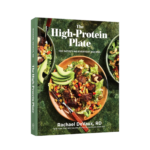
Lactose intolerance is incredibly common—about 68% of the world’s population experiences some degree of it (1). Many people notice it gets worse as they get older, since the body naturally produces less lactase, the enzyme needed to break down lactose. But for those of us who love cheese, giving it up entirely isn’t an easy option. One question I get super often: is goat cheese easier to digest for lactose intolerance?
I personally have lactose intolerance, but I’ve found that goat’s milk cheese works great for me—I never experience the bloating or discomfort that comes with cow’s milk cheese. After looking into the science over the years, it turns out there are several reasons why goat cheese is easier to digest and may become a great option if you’re also lactose intolerant!
1. Goat Cheese vs Cow’s Milk: Which Is Easier To Digest?
Lactose intolerance occurs when the body struggles to digest lactose, the natural sugar in dairy. While goat’s milk does contain lactose, it has 10–12% less than cow’s milk (2). For those who are sensitive, this small reduction can make a big difference in digestion.
Additionally, aged goat cheeses like gouda and feta have even less lactose because the fermentation process breaks it down.
2. Easier-to-Digest Proteins
Not all dairy proteins are the same. Goat’s milk contains mostly A2 beta-casein, whereas cow’s milk has more A1 beta-casein (3). Research suggests that A2 protein is easier on the digestive system, whereas A1 protein is linked to more bloating and inflammation (4).
A study published in the European Journal of Clinical Nutrition found that A1 casein from cow’s milk may contribute to digestive discomfort, while A2 casein (found in goat’s milk) is associated with fewer symptoms (5).
3. Smaller Fat Molecules = Easier Digestion
Goat’s milk also differs from cow’s milk in its fat structure. The fat globules in goat’s milk are smaller and naturally homogenized, meaning they are easier for the body to break down and absorb (6).
Additionally, goat’s milk is richer in medium-chain triglycerides (MCTs), a type of fat that is quickly metabolized for energy instead of being stored in the body (7). This makes it a gut-friendly option for those who struggle with traditional dairy.
4. Lower Levels of Allergenic Proteins
Some people who assume they’re lactose intolerant may actually be sensitive to proteins in cow’s milk, like alpha-S1 casein. Goat’s milk has much lower levels of this protein, making it a better option for those with dairy sensitivities (8).
A 2019 study in Nutrients found that individuals who experienced digestive distress from cow’s milk had fewer symptoms when consuming goat’s milk products (9).
5. Nutrients That Support Gut Health
Goat’s milk is packed with nutrients, including calcium, magnesium, and vitamin A, but it also contains prebiotic oligosaccharides that support gut bacteria (10). This means it may not only be easier to digest but can actively improve gut health over time– HUGE.
Is Goat Cheese Easier To Digest For Lactose Intolerance?
Goat cheese is easier to digest for lactose intolerance, and may be a great alternative if you struggle with lactose intolerance or dairy sensitivity. With its lower lactose content, A2 protein, smaller fat molecules, and gut-friendly properties, it’s no surprise that many people (myself included) find it much easier to digest than cow’s milk cheese.
If cow’s milk cheese has never agreed with you, switching to goat’s milk cheese could be a simple change that makes all the difference.
Wanting to try some recipes that include goat milk instead of cow’s milk? Fear not! Most of my recipes on my site are actually made with goats milk or cheese, or include a substitution for it. Try my Gluten Free Crispy Chicken Parm, Prep Ahead High-Protein Breakfast Sammies, or BBQ and Cheddar Goat Cheddar Chicken Taquitos.
More Resources
My Best 110+ Healthy Recipes (Dairy-Free, Gluten-Free, Refined-Sugar Free) all inside my NYT Bestselling Cookbook, Rachael’s Good Eats
Struggling To Eat Enough Protein? Check Out This Post: What I Eat In A Day (100+ Grams Of Protein)
The Unexpected Superfood I’ve Been Loving As A Dietitian
References
- Matthews, S. B., et al. (2005). Symptoms of lactose intolerance in the general population. European Journal of Clinical Nutrition, 59(6), 718–726.
- Park, Y. W. (2010). Goat milk—Chemistry and nutrition. Small Ruminant Research, 38(2), 97–106.
- Nguyen, T. T., et al. (2015). Comparative digestion of A1 versus A2 beta-casein variants. European Journal of Clinical Nutrition, 69(8), 929–934.
- Jianqin, S., et al. (2016). A1 vs. A2 beta-casein and effects on digestion. Nutrition Journal, 15(1), 35.
- Rangel, A. H. N., et al. (2016). Comparative analysis of cow, goat, and buffalo milk proteins. Food Science and Technology, 36(3), 605–612.
- Haenlein, G. F. W. (2004). Goat milk in human nutrition. Small Ruminant Research, 51(2), 155–163.
- López-Aliaga, I., et al. (2010). Goat milk improves iron bioavailability. Journal of Dairy Science, 93(4), 1621–1627.
- Bevilacqua, C., et al. (2001). Digestibility of goat milk proteins vs. cow milk proteins. Journal of Dairy Science, 84(6), 1235–1240.
- Albenzio, M., et al. (2019). Gut microbiota and goat milk consumption. Nutrients, 11(8), 1935.
- Lara-Villoslada, F., et al. (2006). Prebiotic properties of goat milk oligosaccharides. British Journal of Nutrition, 96(5), 866–874.
















Comments